Giant delicious orange fruits - orange strawberry tomato
Orange strawberries have been grown in Russian gardens for over 40 years. And of course, for such a long time, the variety managed to conquer all regions of our country. This is perhaps the most famous variety of yellow-fruited tomatoes.
In the Mediterranean, these vegetables are called golden apples, and American scientists claim that eating sunny tomatoes slows down aging. In addition, yellow tomatoes are ideal for baby and diet food.
The content of the article
Characteristics and description of the variety
Tomato Orange strawberry comes from a variety obtained by German breeders. In 1975, the tomato German orange strawberry was brought to Russia.
Russian gardeners, leaving only the strongest and healthiest specimens of seeds for the next planting, have improved this variety and developed a new culture on its basis.
Distinctive features
Bush indeterminate, powerful, 1.7-2 m high in the open field. In greenhouse conditions, the growth of the main stem reaches 3.5 m. The first brush is laid over 8 leaves, the subsequent ones - every 4 leaves.
Each brush sets 4-6 fruits of the same size. The ovaries are formed even at high air temperatures. The leafiness is medium, the leaves are dark green. The root system grows superficially.
A mid-ripening variety, from the moment of planting to full maturation, 100-110 days pass. When ripe, vegetables do not crack.
The yield is high, up to 6 kg of fruits are harvested from 1 seedling when placed on 1 sq. m no more than 3 plants. Fruiting is extended, ripening in greenhouses lasts until the first frost.
Tomato is characterized by persistent immunity against diseases of fungal and viral etiology.
Tall bushes require the obligatory formation and garter of the main stem and fruit-bearing branches.
Fruit characteristics

The average weight of fruits in the open field is 400-600 g, in greenhouse conditions - up to 900 g. The fruit is heart-shaped, rich orange in color.
The taste is excellent, sweet with fruity notes and slightly noticeable sourness. The deep orange color is attributed to carotene, which is found in large quantities in the fruit.
The pulp is juicy, there are 4 seed chambers, few seeds. The rind is thin, but dense, not prone to cracking.
Ripe vegetables withstand transportation well, the main condition is not to stack them too tightly to each other.
The photo shows the tomato variety Orange Strawberry.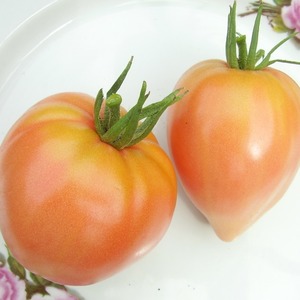
How to grow seedlings
Sowing work is carried out at the end of March, 2 months before transplanting into the ground. Tomatoes are grown only in seedlings.
Seed preparation
Varietal crops provide an opportunity for self-collection of seed. But, as a rule, such planting material needs proper disinfection.
Initially, seeds are rejected, disposing of twisted and dark colors. Then they are checked for emptiness inside. To do this, dissolve 1 teaspoon of salt in a glass of water and place the grains in the solution for 10 minutes.
The ones that float to the surface will not sprout, so they are disposed of. Disinfection is carried out in a weak solution of potassium permanganate for 20 minutes. After that, it is washed with running water and dried.
reference... Instead of a manganese solution, you can use 2% hydrogen peroxide.
To increase the percentage of germination, seeds are germinated on damp gauze. The grains are laid out on gauze, moistened with warm water and left in a dark place for 2-3 days until sprouts appear. As it dries, the gauze is sprayed with warm water.
Capacity and soil
For seed germination, a nutritious soil is prepared from sod land, sand, peat and wood ash in equal amounts. After thorough mixing of all components, the resulting mixture is spilled with a hot solution of potassium permanganate or steamed in an oven at a temperature of 50 ° C for 15 minutes. Disinfection of the soil is necessary, otherwise disease-causing spores will destroy all plantings.
The disinfected soil is laid out in prepared containers, having previously made small holes at the bottom for drainage.
reference... Drainage is necessary to drain excess moisture.
You can plant in a common wooden box or use individual containers, for example, paper honeycombs, plastic cups and peat pots.
Sowing
Seed material is buried 2 cm, leaving a distance between them of at least 1.5 cm. Sprinkle with peat, slightly compact, watered with warm, settled water using a spray bottle and covered with foil or glass to create greenhouse conditions. The seeded containers are left in a bright room at a temperature of 22 ° C.
We take care of seedlings
As soon as the shoots appear, the containers are immediately rearranged on the windowsill. Daylight hours for seedlings provide at least 16 hours. With a lack of light, the sprouts will stretch and weaken. Therefore, you should take care of installing phytolamps in advance. It is not recommended to light up the seedlings for more than 16 hours, since vital processes take place in the dark.
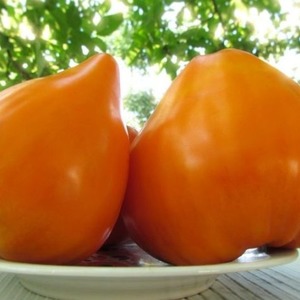 Water should be watered as the upper soil layer dries up with warm, settled water with a shallow watering can or a tablespoon along the edge of the containers. It is not necessary to fill the sprouts, otherwise you can provoke rotting of young roots or the development of fungal diseases. After watering, the soil is loosened superficially so that the soil is better saturated with oxygen.
Water should be watered as the upper soil layer dries up with warm, settled water with a shallow watering can or a tablespoon along the edge of the containers. It is not necessary to fill the sprouts, otherwise you can provoke rotting of young roots or the development of fungal diseases. After watering, the soil is loosened superficially so that the soil is better saturated with oxygen.
As soon as 3 true leaves are formed, the seedlings are dived, seated in separate containers, or left in a common container, but with a distance between the seedlings of at least 15 cm.At this moment, the first feeding is applied in the form of a complete complex fertilizer. Top dressing must be combined with watering.
2 weeks before planting in the ground, the seedlings are hardened - they are taken out into the street in the daytime for 1 hour at a temperature of 16 ° C. Gradually, the time spent outdoors is increased to 10 hours, while the night temperature in the room is reduced to 12 ° C.
How to grow tomatoes
After the soil warms up to 18 ° C, the seedlings are transplanted into the ground. By this time, 5-7 true leaves and a well-developed root system are formed on the bushes.
Landing
The soil is prepared in advance, dug up with the introduction of mineral fertilizers. They make holes 15 cm deep and fill them with water.
Planting pattern: 50 cm - distance between seedlings, 65-70 cm - between rows. For 1 sq. m place no more than 3 plants.
They are planted vertically, deepening to the first leaves. After landing, the earth is compacted, watered warm water and left to get used to new conditions for 10 days.
Taking care of the tomato Orange strawberry
As soon as the young plants take root in the soil, regular watering is established. In normal weather, water no more than 2 times a week... Depending on drought or rainfall, irrigation is adjusted as needed. It is important to prevent waterlogging of the beds, otherwise the spread of fungal diseases is possible. In greenhouses, drip irrigation is installed so that the humidity level does not go beyond the normal range.
Watered with settled water under the root, without getting on the leaves. After watering, the soil is loosened and weeds and roots are removed.
Mulching the beds retains moisture, which is very convenient on dry days.
Top dressing apply 3-4 times for the entire growing season. They are fed for the first time 2 weeks after transplantation. Mullein infusion is used as fertilizer in a ratio of 1:10. The same top dressing give during flowering. At the time of fruiting, they are fed with a full range of minerals, mainly containing potassium and phosphorus.
Features in care and possible difficulties
The formation of tomatoes is carried out to obtain the maximum return. The culture is formed into 2 stems, removing the stepsons. With the growth of stepchildren, the plantings thicken, which inevitably leads to plant diseases. All lower leaves are cut to the first fruiting branch.
reference. Stepsons Are lateral branches growing from the leaf sinuses.
You cannot do without a garter when growing indeterminate plants. When transplanting, a support is installed next to each bush, to which the stem and fruitful branches are fixed as they develop. Also, tall seedlings are fixed on a trellis, to a horizontally stretched wire. Fixed bushes form a strong and even stem, and picking ripe fruits from tied branches is much easier.
Diseases and pests
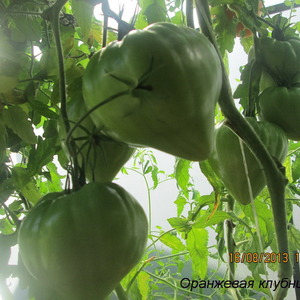
Tomato is characterized by increased resistance to diseases of the nightshade family, but, nevertheless, prevention cannot be neglected. If you monitor the level of moisture in the beds, avoiding waterlogging, you can avoid not only the spread of fungal infections, but also prevent invasions of pests such as slugs, aphids and the Colorado potato beetle. Systematic loosening gets rid of pests living in the ground, and planting pungent-smelling grasses next to tomatoes - from flying pests.
It is important to remember that if potatoes or peppers are planted nearby, preventive measures are required for all crops. This is due to the fact that they belong to the same family and are affected by the same diseases.
Folk recipes are advised to spray tomato seedlings with a decoction of nettle and plantain. Such a strong infusion scares away many parasites.
With a large accumulation of insects, insecticides are used, otherwise many plantings will be destroyed.
Nuances when breeding in open ground and in a greenhouse
The growth of greenhouse plants reaches 3.5 m. This is a great height, and the root system is not always able to fully provide the plant with nutrients.... To restrict growth, the crown of the plants is pinched. If this is not done, a lot of nutrients will be spent on building lateral shoots and leaves, and not on the formation of ovaries.
When planting in open ground, you must take care of the correct choice of beds. It is preferable to place them on the sunny side, protected from through winds. With a lack of sunlight and nutrition, yields are significantly reduced, while a drop in temperature is tolerated by the culture. Another threat to fruiting is the north wind.
In the greenhouse, the fruits reach more weight than in open beds, there are even cases when tomatoes grew by 1 kg. But here it is important to understand that the larger the fruits, the less they should be in a fertile brush. Therefore, the number of ovaries is reduced to 2-3.
Harvesting and application of the crop
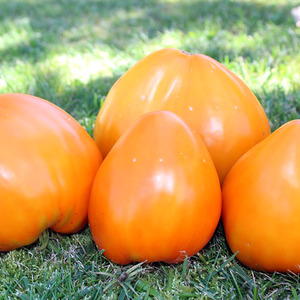
The mid-season species ripens in late July - early August. Due to the extended fruiting, vegetables are harvested until October. When harvesting, the entire fruit cluster is cut off.
The purpose of ripe tomatoes is universal: from summer salads to winter preparations. Red tomatoes are added to make canned juices acquire a richer hue. Yellow vegetables are great for baby food and diet meals.
Ripe vegetables retain their presentation for a long time and withstand transportation well over long distances.
Advantages and disadvantages of the variety
Let's start this section with numerous benefits:
- the possibility of breeding in all regions;
- the ability to form ovaries in any conditions;
- high rate of fruiting;
- strong immunity to diseases;
- unpretentious care;
- extended fruiting;
- excellent fruit taste;
- unusual shape;
- versatility in cooking;
- long storage;
- the possibility of self-collection of seeds.
Negative characteristics include mandatory garter, bush formation and pinching.
Learn more about German Orange Strawberry
As mentioned just above, this is actually the progenitor of the orange strawberry tomato. Therefore, the characteristics and growing conditions are very similar. The only difference is that the German variety can be grown in 2 ways: seedling and non-seedling.
The German orange strawberry tomato belongs to the indeterminate type with a plant height of up to 1.8 m in the open field and up to 3.2 m in a greenhouse. The variety is mid-season, harvesting begins 110 days after sowing the seeds. The yield is high, 5-6 kg are harvested from 1 seedling. It is not afraid of a sharp temperature drop, forms ovaries under any conditions. Differs in resistance to diseases and pests. Requires compulsory shaping and garters.
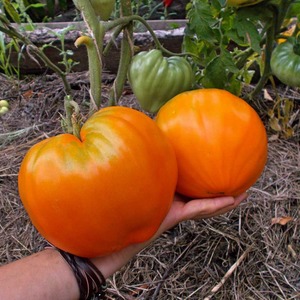 The average weight of fruits is 400-700 g, the shape resembles a heart, the color is rich yellow or bright orange. The taste is excellent, sweet with a fruity undertone and barely noticeable acidity.
The average weight of fruits is 400-700 g, the shape resembles a heart, the color is rich yellow or bright orange. The taste is excellent, sweet with a fruity undertone and barely noticeable acidity.
The purpose in cooking is universal: the taste is preserved both in fresh dishes and in winter preparations. When transporting long distances, tomatoes are not recommended to be stacked tightly. Ripe vegetables retain their presentation for 2 weeks.
Farmers reviews
Many novice gardeners are guided by the opinions of experienced gardeners. Reviews about this variety will help you make the right choice.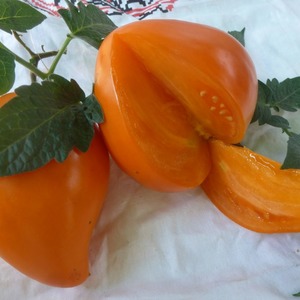
Anton, Arkhangelsk region: «Not a single seedling shed any flowers or ovaries even in the heat. The bush is tall, but does not take up much space. Tomatoes are smooth, large, warm orange. The fruity note in the taste is spicy in salads, and it is noticeable when mixed with any vegetables. "
Nadezhda, Klin: “The bushes grew up to 2 m. They formed 2 stems. A lot of ovaries formed, the weight of ripe tomatoes reached 300-450 g. The shape was not all like a heart, rounded tomatoes were born. The taste is simply delicious. I advise everyone to plant them in their beds. "
Conclusion
Tomato culture is interesting not only for its giant heart-shaped fruits, but also for its advantages in breeding. As a rule, the more unusual the fruits, the more difficult it is to care during the growing season. But not for the "strawberry" tomato. It is distinguished by simple agricultural technology, resistance to pests and diseases, and high yields.
Taste qualities can leave many popular varieties far behind. This tomato is the undoubted favorite among other yellow-fruited crops.